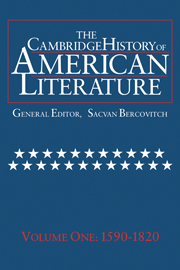Book contents
- Frontmatter
- Introduction
- THE LITERATURE OF COLONIZATION
- NEW ENGLAND PURITAN LITERATURE
- BRITISH-AMERICAN BELLES LETTRES
- THE AMERICAN ENLIGHTENMENT, 1750–1820
- 1 Finding the Revolution
- 2 What is Enlightenment? Some American Answers
- 3 Religious Voices
- 4 Writing the Revolution
- 5 The Literature of Public Documents
- 6 The Limits of Enlightenment
- THE LITERATURE OF THE REVOLUTIONARY AND EARLY NATIONAL PERIODS
- Chronology
- Bibliography
- Index
2 - What is Enlightenment? Some American Answers
from THE AMERICAN ENLIGHTENMENT, 1750–1820
Published online by Cambridge University Press: 28 March 2008
- Frontmatter
- Introduction
- THE LITERATURE OF COLONIZATION
- NEW ENGLAND PURITAN LITERATURE
- BRITISH-AMERICAN BELLES LETTRES
- THE AMERICAN ENLIGHTENMENT, 1750–1820
- 1 Finding the Revolution
- 2 What is Enlightenment? Some American Answers
- 3 Religious Voices
- 4 Writing the Revolution
- 5 The Literature of Public Documents
- 6 The Limits of Enlightenment
- THE LITERATURE OF THE REVOLUTIONARY AND EARLY NATIONAL PERIODS
- Chronology
- Bibliography
- Index
Summary
The Enlightenment in America is sometimes conveyed in a single phrase, the political right of self-determination realized. The reduction is possible because self-determination as a philosophical principle incorporates the basic eighteenth-century tenets of Enlightenment thought: the primacy of reason, the reliability of human understanding, the value of individual freedom, trust in method, faith in education, belief in progress, and a corresponding disregard for tradition, constituted authority, and received dogma. At the same time, the realization of self-determination in national ideology has tended to equate philosophical principle with political practice. Since the Revolution claims government by consent of the governed as the irreducible source of its achievement, self-determination becomes the sign and symptom of the Enlightenment at work in each succeeding generation. This is the legacy of the Revolution in daily life.
Not coincidentally, the Enlightenment has been a partisan concept in American historiography, one in which subsidiary notions of liberalism, progress, and rationality have shaped the character of historical reconstructions. Because the idea of an American Enlightenment coincides with national formation and a developmental sense of country, its proponents tend to dwell on the emerging prospect. They see and make use of the original aspiration of human freedom but lose all sense of the Enlightenment as a historical process with its own patterns of constraint. The result is a peculiar one-sidedness or intellectual vulnerability in critical inquiries about the subject.
- Type
- Chapter
- Information
- The Cambridge History of American Literature , pp. 368 - 389Publisher: Cambridge University PressPrint publication year: 1994

